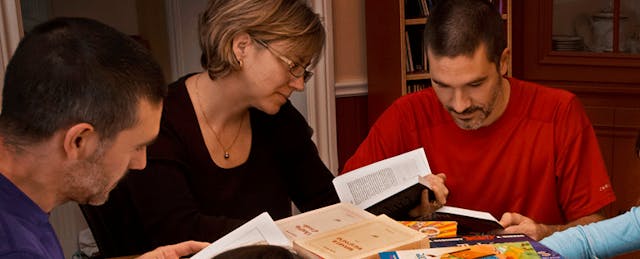There are tons of apps and web-based programs that help kids learn to read, but precious few to help low-literacy adults. And it’s not due to a lack of need: One of every six adults in America--36 million people--struggle with reading and comprehension, and federal funding for adult education has plummeted 20% over the past decade.
So how do you use tech to teach reading to adults who can’t? How can design help adult learners develop skills to get better jobs? EdSurge asked adult digital education experts what they’ve discovered. Here’s what we found out:
1. Design for adults, not children
“We can’t treat them like kids,” says Matt Robinson, director of distance learning at Goodwill Community Foundation Learn Free. So, no butterflies and flowers. Instead, GCFLearnFree, which has 10 million users annually, uses original art that’s made for adults, like this grocery store scene.
2. Make it pertinent to their lives
Adult learners are trying to build skills to get a better job, so designing for their real-life challenges and ambitions is key. In educational circles, it's is called “contextualization.” This creative job application tutorial from GCFLearnFree gives students practical experience filling out forms.
3. Respect their time
“Adult learners tend to have busy lives,” says Robinson, and often “have less time” than many other adults. So GCFLearnFree tries to keep learners engaged longer when concepts require more concentration, but cuts them loose early when an idea is quick to comprehend. And, in the interests of respecting a learner’s limited time, Robinson says, “You need to give them a user interface that works really well, that’s clean, that shows the intent, that keeps people from getting stuck or confused.”
4. Inject humor
Adult learners can be apprehensive about working on computers--but as Robinson says, “humor helps break down barriers of fear.” The GCFLearnFree team has made reading comprehension texts funny, when possible, and added humorous graphics (like this line drawing of George Washington on a laptop) that can help relax the learner and keep him or her coming back.
5. Use all available tools
People are responsive to different kinds of teaching, so GCFLearnFree uses video, sound, art, storytelling, icons and text--often all of the above--to help reinforce a concept and make it memorable. This is one funny video (combining Tips 4 and 5!) that teaches the difference between the words “literally and figuratively.”
6. Talk back to the critical internal dialogue
Adult learners can be hard on themselves! They often have a critical internal narrative that pops up when they encounter a hard academic problem, says David Goldberg of Core Skills Mastery. “They’ll often put down their pencil and tell themselves, ‘I can’t do this because I’m not smart enough, or they never taught me, or worse, they taught me and I forgot it,’” he explains. All too often, this “learned helplessness” leads a student to give up.
To redirect this mindset, Core Skills Mastery shows each student encouraging data, like this pop-up which says, “only 40% of all adults and 70% of 4-year college graduates can complete this skill.” Ideally, the data will prompt students to realize that they are not alone, they are not stupid, and that the problem is hard for most people. Goldberg says that with the right encouragement, the internal narrative can then change to, “If I spend 5 minutes on it, I can learn it, and then I can do a fist pump because I can do a skill most people can’t.”
7. Praise the effort and the process, not the skill achieved
Instead of showing simple green checkmarks for skills achieved or red “x” marks for incorrect answers, adult learning sites should “be specific in encouraging the behaviors--like persistence, confidence and self-reliance--that give rise to success,” says Goldberg of Core Skills Mastery. “It parallels best practices in parenthood and teaching.”
One way CSM encourages persistence is by temporarily guiding students to an easier problem set when they are struggling with a hard problem. This way, Goldberg says, the student will regain confidence and return to the tough problem with more grit.
8. Make the text adaptable
Adult learners may not be native English speakers or may have trouble seeing words on a screen. Dr. Jill Castek, part of the Portland State University development team of LearnerWeb recommends features that allow for simultaneous translation and font adjustments, enabling easier reading.
9. Build for the tech they have
Lots of adult learners have phones, but they don’t necessarily have laptops or computers. Gabe Martinez Cabrera, a program manager of Adult Education Initiatives at Digital Promise says, “Embrace the tech they have, don’t build for what they don’t. Adult students are often mobile but [without access to] Wifi.”
10. Make it social
The best adult learning programs build in social support with other real people. “A program where adult learners can interact with other people supports engagement,” says Dr. Castek. “We believe live and in-person connections are especially important with adult learners.” Or as Cabrera of Digital Promise says, “Use tech to the limit, then use people when tech falls short.”


